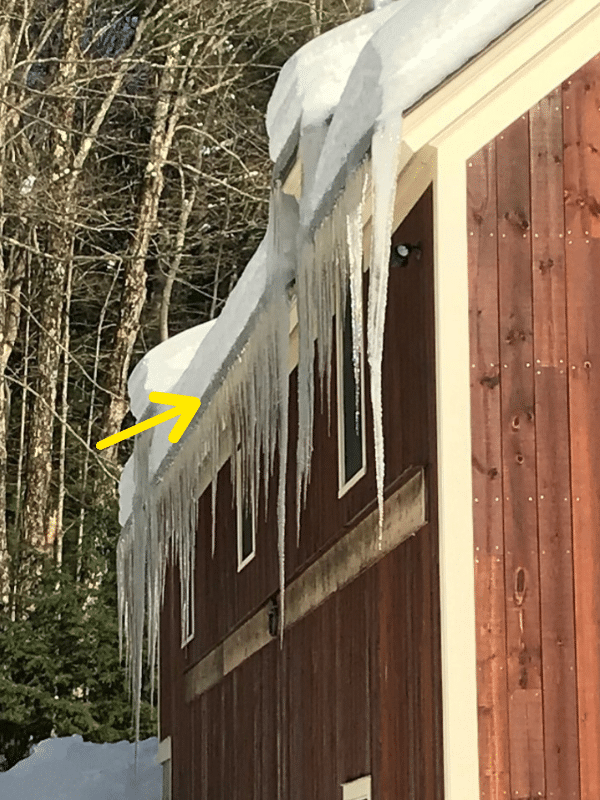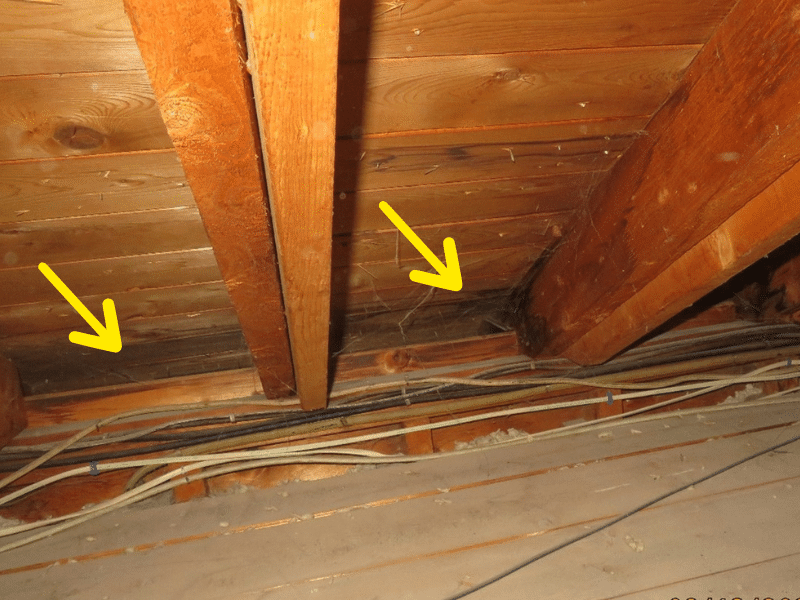What is an Ice Dam?
Ice dams are typically caused when ice builds up along the eaves of a sloped roof (see Figures 1 and 2). Melting snow runs down the roof and for a variety of reasons discussed here, refreezes along the eaves (bottom edges). Once created, the ice blocks melt water from flowing off the roof, resulting in further ice buildup.
Why are Ice Dams Bad?
By blocking the drainage path of water on the roof, ice dams can have a negative effect on a sloped roof. Once the ice dam forms, water from melting snow or subsequent rain events is trapped on the roof, upslope of the ice dam. Typical shingle roofs are not waterproof barriers: their purpose is to prevent moisture from entering the building envelope by shedding water down the roof slope. A buildup of standing water can find its way beneath the shingle tabs and ultimately into the structure. If not properly mitigated, this moisture can
- Cause immediate damage to finishes,
- foster the growth of mold, and
- lead to wood rot.
Additionally, the weight of the ice can have negative effects on gutters installed along the eaves.
What Causes Ice Dams?
Ice dams are typically caused by a lack of proper insulation and/or ventilation in the building. Usually, when sun exposure or warm temperatures cause snowmelt on a roof, there is a relatively even or uniform melt of snow, allowing the melt water to freely flow off the sloped roof. When the snow melts due to warm temperatures on the underside of the roof structure, the perfect environment for an ice dam to form is created. The warm air that rises up to the underside of the roof sheathing causes snow melt, especially at the high points of the roof. The water then flows down the slope and re-freezes along the roof eaves, due to
- Warm air’s tendency to rise towards the roof ridge,
- the presence of the roof overhang, and
- the general geometry of a sloped roof.
If an attic space or roof area is not properly insulated, e.g. an inadequate amount of insulation or voids in the insulation, warm air from the heated portions of the building will rise up to the underside of the roof sheathing and cause snowmelt at the top side of the roof. Similarly, roof ventilation is intended to remove any warm air that does enter the space at the underside of the roof sheathing. If there is proper roof ventilation, the warm air that makes its way up through the insulation is exhausted through the roof vents. However, if the roof has inadequate ventilation, this warm air builds up on the underside of the roof sheathing, causing snow at the top side of the roof to melt
How to Spot an Ice Dam
Ice dams can be difficult to identify, especially on taller roofs. Some possible indications of an ice dam include:
- Water that has entered the interior or attic of the building during the winter, especially along the eaves
- Icicles hanging off the roof accompanied by a build-up of ice on the roof surface can be an indication of ice dams, but icicles alone do not necessarily mean that an ice dam is present.
The best way to locate an ice dam is to remove any snow from the edge of the roof and visually inspect for a buildup of ice.

Figure 1. Example of Ice Dam. Note icicles and layer of ice visible on roof surface at the roof eave.

Figure 2. Example of moisture staining on the underside of roof sheathing at the roof eave.
Ice Dam Prevention and Mitigation
The best way to prevent ice dams is to ensure proper insulation and ventilation. Other ways to help mitigate the effects of ice dams are to
- Scrape or shovel the roof after every snowstorm,
- ensure proper roof underlayment is installed at the eaves, or
- install heat tracing along the roof eaves.
Ultimately, while these mitigation methods will help alleviate the effects of ice dams, the best method is to prevent the conditions that cause ice dams from developing in the first place.
There are certain building code requirements for insulation and roof ventilation. VERTEX can assist with navigating those codes and determining the cause of ice dams at your property.
To learn more about VERTEX’s Forensic Consulting Services and Expert Witness Services, or to speak with a Forensic Engineering Expert, call 888.298.5162 or submit an inquiry.




